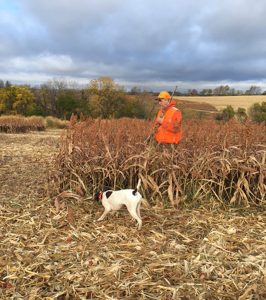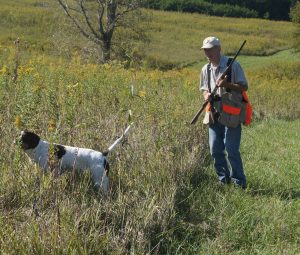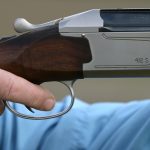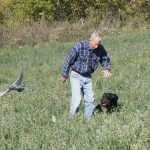Game Preserves for Training
POINTING DOG POINTERS FEBRUARY 2016
By Bob and Jody Iler
As the hunting season draws to a close, many of us have the opportunity to continue hunting with our dogs in the field at a nearby game preserve. Open from the fall until late March, game preserves offer a great way to get out with our dogs, extending bird work and conditioning for a few more months.
Though they can’t replace wild bird hunting, game preserves offer many advantages. You can pay for a full or half day’s hunt and still be back home on the same day, spending much less money than you do on hunts involving long distance trips with gas and lodging costs. You can choose the number and type of birds (pheasants, chukers, and quail) that you want released and save money there as well.
At most preserves you’ll find mowed paths between various types of cover making it easier for both older hunters and young, inexperienced pups to navigate. Preserves often offer facilities where you can clean your birds before you leave; some will do that chore for you. And many have an area where hunters can gather, offering camaraderie and sharing stories about their dogs.
But what about using the game preserve as a training ground for your dog?
As you’ve heard many times, bird dogs need birds, birds and more birds to develop their potential. Hunting on wild birds will teach your dog many invaluable lessons over the years, but can also represent the polar opposites of what a young dog needs in his early bird development.
You don’t want to hunt a green dog all day on public hunting land and not find any birds – these pups must find birds to keep their drive and enthusiasm kindled, or they’ll forget why they’re out there! On the flip side, taking the young dog to theDakotasto hunt, where there will be wild flushes of huge flocks of pheasants can do more damage than good to a green pupil’s development. And, with hunting birds in the wild, there is no way you can control what may happen, good or bad.
Game preserves, on the other hand, offer the best chance that your pup will find birds. You’ll decide what type of birds you want to use. Maybe you have a shy pup that would benefit from quail work, giving her more confidence. Maybe you want to work your dog on a bird that will sit tight and then flush well, so you choose chukars. Perhaps your pup is ready to test his ability on the ringnecks and you’ll use those as your bird of choice. Plus, at the game preserve, you can work a young dog on a hen for his first introduction to pheasants, offering less chance of pup getting spurred by a rooster.
You can choose to have the birds released or, as we often do, plant the birds yourself, one or two at a time, and set up your own training scenario. We may use the dizzying method or traps to plant birds, depending on what level of training our dog is at. And in doing this, we try to ensure that our pup won’t have the opportunity to catch the bird. For example, with young dogs, we’ll use a checkcord to work them into a bird placed under a trap, and we’ll have a helper flush the bird.
If your dog has had a good bit of experience on all types of game birds and is doing well, you may want to have the preserve manager release the birds for you and just go on a regular “hunt.” The ability to control the bird situation is extremely helpful in developing your pup, but an important part of that is simply having fun now and then. Also, as you see what happens during these fun hunts, you can assess your training program and address any problems that develop.
Point is, with game preserves, you can tailor your program to suit the stage your pup is at. If you’re trying to encourage your pup to retrieve naturally, you may want to use quail, since starting out with the retrieve of a smaller bird often helps to encourage a pup to pick it up. If you are trying to put more handling control into your pup, you can plant a bird ahead of time and work him on a checkcord to remind him that first and foremost, he is hunting with and for you.
Game preserves can also be good scenarios for doing the “polish” work on your finished dog. You may be working on steadying your dog to wing and shot or honoring (backing) another dog. By choosing where to plant your birds in a “setup” situation, you can ensure a more successful training session. This would be much more difficult with wild birds, as it’s hard to predict what might happen.
One disadvantage of game preserves to keep in mind is the fact that though you can control many aspects of your training and your hunts at the preserve, you are working with pen-raised birds. Most preserves have very large areas where the birds are raised and have plenty of opportunity to fly and develop into hardy game birds. And yet, preserve birds can sometimes inadvertently cause training issues with your young dog, especially if they hunker down, don’t flush, and are caught by your pup, or simply run and don’t flush and are also caught by your pup.
With game preserves, you pay for the privacy of hunting a certain area without the distraction of other hunters or dogs, enabling you to concentrate on training and tweaking those development issues that can crop up with your dog. You have the opportunity to expose your pup to plenty of birds, retrieving opportunities, and variety of cover to hunt in. Most important of all, you expand the time that you and your pup have to share these treasured times in the field together. Good luck!
Pointing Dog Pointers features monthly training tips by Bob and Jody Iler, who own Green Valley Kennels in Dubuque, Iowa. Bob and Jody have trained pointing dogs for over 35 years and have written many articles for Pointing Dog Journal.








